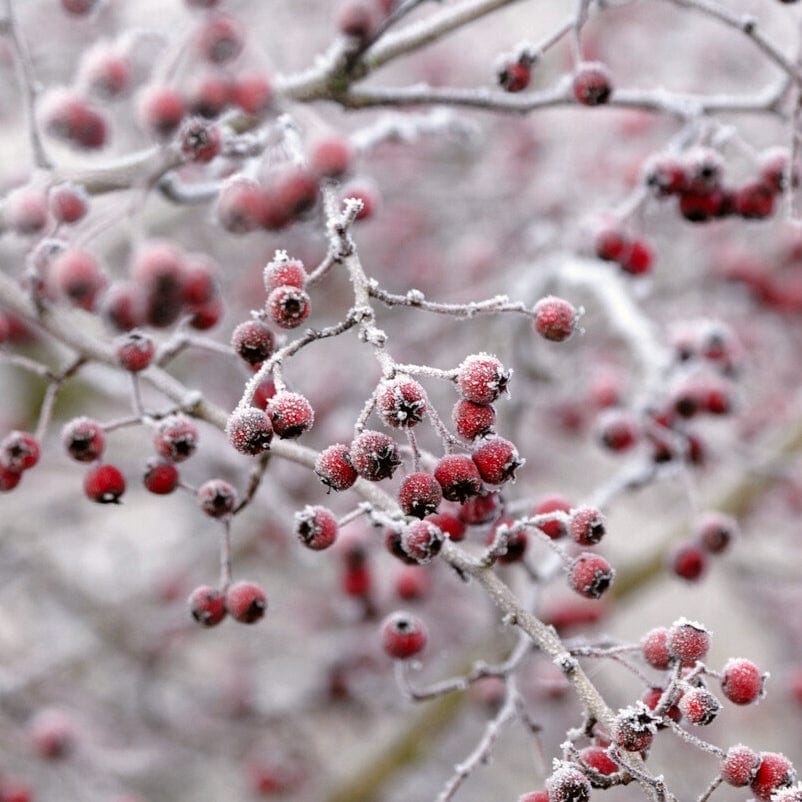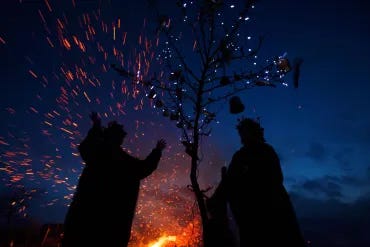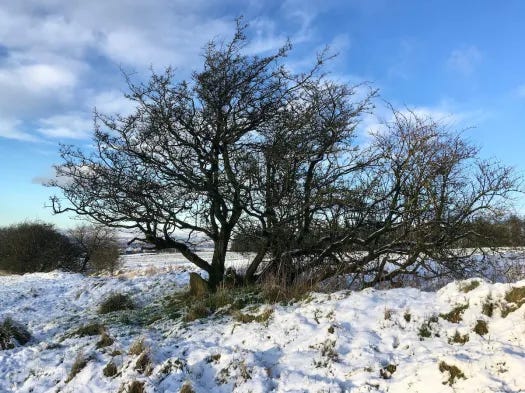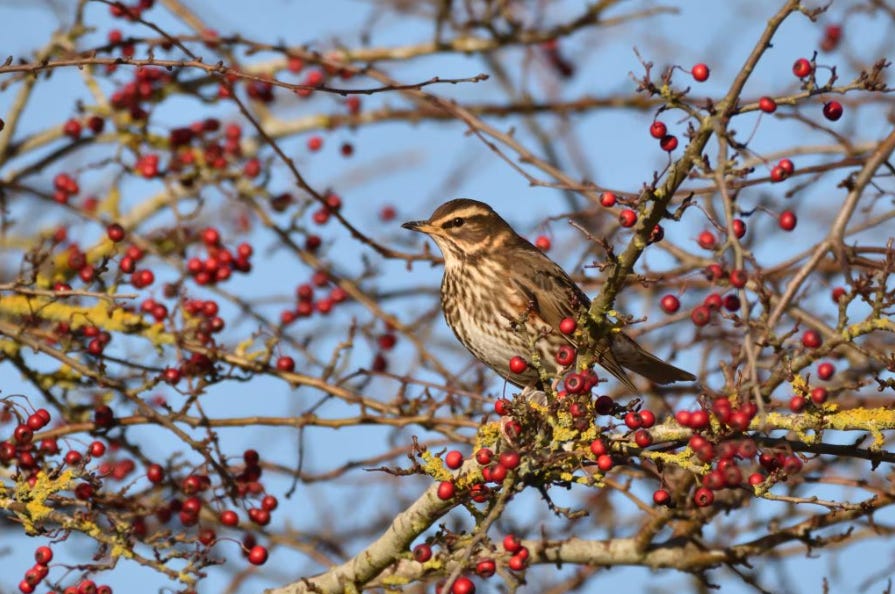The wintry haw is burning out of season,
crab of the thorn, a small light for small people,
wanting no more from them but that they keep
the wick of self-respect from dying out,
not having to blind them with illumination.
Seamus Heaney, ‘The Haw Lantern’
Felicitations, dear Twelvetiders and a very Happy New Year to us all! I hope and pray that it will be a good one for all beings, and where that is not so may there be solidarity and hope.
Before I begin my series on the Twelve Days of Christmas for Old Twelvetide, we have New Year’s Day to attend to, amongst several other delights in this season of frost and stars. I have noticed, with some surprise, in the last few days quite a few new readers of my series from last summer; “Journeying with the Holy Thorn”, which was my Plant Spirit Challenge for 2024. You can read the posts about my experiences with the Hawthorn Being beginning here if you would like to. The first sharing also explains the Plant Spirit Challenge, which I have been attempting with, sometimes a lot and sometimes less, success since 2019. It was invented by Michelle Simkins and is a wonderful thing to do. I highly recommend it if you love plants, or life.
In 2024 I managed to get to day 11 of the challenge before falling away, mainly because the hawthorn trees of my deep devotion, which I was able to walk to from the hedgehermitage, were cut down by the council to make way for a barbed wire fence, in what my new Substack friend, Jez of
would describe no doubt as an act of ‘corporate fuckery’. You can read my thoughts on such things here in ‘Soliphilia: On the Seeing of Stars’. I had always meant to return to my writings on it in my own chaotic way, but never quite did. Imagine then my delight when I discovered that there is a folk tradition involving the hawthorn tree here at the dawn of the year; Burning the Bush! Linked to the Wassailing tradition of blessing the fruit trees for the coming year, Burning the Bush sees out the year that’s been.Throughout the year, particularly in and around Hereford, a globe of bent hawthorn branches seasoned with cider would be hung from the ceiling of kitchens to ward off diseases and ill-intentioned spirits. New Year’s Day was the time to remove the old globe and replace it with a new one, at which time the old globe would be placed on a bed of burning straw and carried across the family’s fields. If it blew out during the journey it would signify a poor growing year ahead. A similar tradition took place in Worcestershire, but there a crown of blackthorn would take the place of the hawthorn.1
Victorian clergyman and diarist Francis Kilvert wrote about Burning the Bush at the start of a new year in his diary entry of Monday, 31 December 1877;
“I sat up till after midnight to watch the Old Year out and the New Year in. The bells rang at intervals all the evening, tolled just before the turn of the night and the year and then rang a joy peal, and rang on till one o’clock. After I had gone to bed I saw from where I lay a bright blaze sprung up in the fields beyond the river and I knew at once that they were keeping up the old custom of Burning the Bush on New Year’s Day in the morning. From the Knap, the hill above the village masked by the two clumps of trees, the whole valley can be seen early on New Year’s Morning alight with fires Burning the Bush, as it can be seen also from the hill at Bettws, Clyro, on which the old Chapel stands.”2
A version of Burning the Bush took place at the old water mill in Putley, Hereford until recent times, and may still do although sadly I can find no references. I think that this may be because it is now a private home, although that is no excuse for neglecting to uphold our folk traditions!
In the Putley tradition, shortly after midnight on New Year’s Day, twelve small bonfires would be lit surrounding a larger central pyre; each kindled with a burning hawthorn globe stuffed with straw on a long pole. When all the fires were blazing, the globe would be thrown into the largest bonfire and, as it burned, fresh hawthorn would be cut to fashion a new globe. This would then in turn be doused with cider and singed in the flames of the old fire, whilst the gathered company chanted ‘old ci-der’ nine times in “low tones”. The globe would then be hung in the mill kitchen until new year came round again.3
Blackthorn Ritualistic Folk, who describe themselves as “Herefordshire’s innovative dark folk performance group”, are keeping this New Year burning tradition alive. In January 2024 they wrote that;
”In Herefordshire around the beginning of the new year there is a tradition of weaving a globe of hawthorn twigs which was then packed with mistletoe (and some hay for ignition). The lantern/bush/globe would be mounted on a pole, set alight, then carried around the fields and orchards where crops had yet to be planted or where seeds awaited the warmer weather, supposedly to symbolise the returning sun and lengthening days. This was done to ensure a good crop, It was thought that without this ceremony the harvest would fail. The custom was widespread on farms and in villages in Herefordshire during the nineteenth century but slowly begin to die out until recently where a handful of people now keep the tradition going. Some say the lantern/bush/globe should be burnt on New Year’s morning before sunrise others say on Twelfth Night/Old Christmas Day (5th of January).”4
You can see a short film of last year’s lantern burning here.
I want to end by writing something of my relationship with the Hawthorn Being during the Plant Spirit Challenge. I have journeyed with several plants in the past; most notably lilac, blackberry, and ground ivy, and found that each one changed me in the deepest of ways. I also tried to build connection with horsetail and ragwort, both of which I adore, but found myself rebuffed! I have been pondering then what I learned from hawthorn.
I have felt a deepening connection with hawthorn over many years; she is my birth tree if you follow the Celtic Tree Calendar, and I have written often of the ways in which our beloved hawthorn fairy tree has been used to separate the people of the Commons from the land. Indeed, I am told that land activists often dislike the hawthorn tree intensely!
Day 2 of the Plant Spirit Challenge is: meditate. I chose to undertake a walking meditation and found that it’s theme was the knocking down of fences. You can read about that here. I feel that lessons about the boundaries and barriers we make were my most powerful teachings from the Hawthorn Being.
On 24th May 2023, something that happened here at the hedgehermitage that felt absolutely fundamental to the message that hawthorn brings. We live in a small community of four cottages on the edge of a housing estate. Each house only has one door, which goes out into the garden. The garden immediately outside the door we refer to as our ‘front garden', then on the other side of the garden fence, there is a communal path that we all have to walk along to get to our houses, and, on the other side of that, another piece of garden which we refer to as the ‘back garden’. It is a strange little set up but it has always worked very well with everyone respecting each other’s space. The back garden between our house and our immediate neighbours’ has never had a fence or dividing line. Then, in May 2023, our neighbour suddenly put one up, destroying many of our plants and a beloved twisted willow tree in the process (and petitioning our landlords to fell our rowan!). But it was the effect that the fence had on our, previously warm and friendly, relationship with our neighbour that was the most striking thing, an effect which led to a violent altercation with my husband because some leaves from the, then living, willow tree had transcended the newly created boundary.
Reflecting on my journey with hawthorn at that time, I wrote in my journal;
“It is as though the fence, which our neighbour erected himself, has created in him a greater sense of ownership and superiority, a sense of us being ‘outside’ and ‘other’ which wasn't there before. Hawthorn has been used to create these conditions for many centuries but, instead of making us confront the dominator, giving credence to the system that has created these arbitrary boundaries and which ‘others’ so many, hawthorn calls us to the hedge.
Even the hawthorn hedges used to exclude the people from their fields during the Enclosures have now become places of sanctuary for plants and animals that otherwise might find no refuge. A study has found that bees, given the choice of the mono crop enclosed field or the hedge next to a busy road, will choose the hedge on the side of the road. They would rather be on the outside and free than on the inside slowly dying from homogeneity. We need to do the same.
Hawthorn teaches that, whilst we must stay present to these acts of micro-aggression, and actual aggression, perpetrated against us and our other-than-human neighbours if we can, we do not have to become what has been done to us. We can choose instead to keep our hearts open and offer shelter to the excluded through acts of wild community and beautiful resistance. By the time the fences fall we will have already created a better and kinder world.”
Allan Stromfeldt Christensen has written that, “bee collapse is the result of their enslavement in industrial monocultures” and that, the bees are in a state of “quasi domestication (I say 'quasi' since honeybees aren't really domesticated but rather retain their wildness while inhabiting artificial domains we provide for them)”5 It feels so much that the same thing has happened to us; that we are taught that we have to put up fences, “inhabit artificial domains”, because someone, although who the someone is we are never quite sure, wants to take what we’ve got and we mustn’t let them. The fences that we build ourselves create the fear, because why would we have a fence if there was nothing to be afraid of; the hawthorn becomes the crown of thorns and we are all crucified.
Following the altercation with our neighbour, we became pariahs in a community that has been our home for many years, because we are the ‘strange ones’; my husband is autistic and I am physically disabled, the work we do doesn’t quite make sense and isn’t quite ‘proper’, we feed gulls and foxes, and we nurture a blackberry bush that takes up half our garden, plus all the ‘weeds’. It taught me, although I already knew, that it is still possible to be ‘witched’, cast out, which I now see is a verb, a deliberate act that takes a coldness of heart created by centuries of Capitalism. This is what happened to women and men who were considered not quite ‘proper’ during the witch trials, it happened to Jesus when the crowd turned against him after his entry into Jerusalem, it is happening to the people of Palestine, and it has happened to our fairy tree, who once provided sustenance to our hungry ancestors with her ‘bread and cheese’ berries and leaves but was enslaved by our ‘betters’ to enable their land theft.
Hawthorn is, and has always been, our ally in maintaining relationship with the land ‘over the fence’, and she is our heart medicine, ensuring that when we do turn the tables we don’t become the oppressor who we seek to shake off; ironically when that blessed day does come there will be many fences that need to be mended.
On 25th July 2023, I wrote in my hawthorn journal that;
“I have been thinking a lot about worlds that exist together but are almost or completely oblivious to one another. For example, the Pagan and Christian worlds in Glastonbury, to both of which the hawthorn is holy.
I have been reflecting that, if we can remain ‘on the hedge’, not quite part of one world or the other, we might choose the sort of world that we wish find ourselves in ~ one that is filled with kind, good people who try, and keep trying, to live together in community, or its opposite; greed, power over, and the building of fences.
A fence is not a hedge. It has no roots, no life, and it can be so easily blown over. We have power in this. And I am more and more interested in thoughts and beings, and religions, that help me find this place between worlds, or that bridge worlds. Goddess-Saint Brigid is one of these, and so is the Hawthorn Being.”
Cardea is the Roman Goddess of door hinges; the place ‘between’, the threshold (where, turning my face towards Candlemas, Brigid was also born). She is also Goddess of the Hawthorn; the fairy tree who turned her enslavement into petals and called in the outcast wild to the field edges in defiance of her ‘masters’, our fairy tree who we find even here at midwinter, at the hinge of the New Year.
And so, let’s hold our haw lanterns high and bless our stolen fields as if they were our own, because surely one day the fences will fall and the barriers and boundaries between us, and between us and this holy earth, will be nothing but blossom and bees.
Free Palestine.
#Christmastide #Twelvetide #Midwinter #HawthornBeing
I am determined to continue offering my work free of charge, because that too is resistance, but if you would ever like to support me with pennies you can do that at https://ko-fi.com/radicalhoneybee. Thank you so much, both for pennies and for all other forms of support, all of which are worth more than their weight in gold.
References:
Seamus Heaney, ‘The Haw Lantern’
Orchard venue for ancient rituals, Hereford Times, 9th January 2004
Reviving an ancient custom, Hereford Times, 6th January 2008
The Monthly Wort: Hawthorn (Part 4), the Mountain Hedgewitch
Sex, Death, and Hawthorn, the Foraging Course Company
Wassailing into a Bountiful 2023, Eat, Sleep, Live
Hawthorn, Burned Thumb; the website of poet, Elizabeth Rimmer
Hawthorn Folklore: Fairies and the May Day tree, Icy Sedgwick, 2020
Hawthorn *Crataegus Monogyna*, The Witch Wench
Burning of the Herefordshire Lantern, Blackthorn Ritualistic Folk on Instagram, 5th January 2024
Hawthorn, Mandy Haggith
Burning red the hawthorn brings to mind moots and magic rituals, Paul Evans, Country Diary, The Guardian, 12th November, 2014
The Hawthorn Tree, Seed Sistas, 2020
The Hawthorn Tree; Magic and Ritual, Snapdragon Life, 2020
Plant of the Week: Winter King Hawthorn, Kentucky Native Plant and Wildlife
Cardea, Thalia Took, The Obscure Goddess Online Directory
‘Maypoles, Martyrs, and Mayhem: 366 days of British myths, customs, and eccentricities’, Quentin Cooper and Paul Sullivan, 1994
As 1.
Old Christmas Day is now 7th January









Fascinated and horrified (but unsurprised) by the relational impact of erecting a fence, and the abrupt dynamic of humans and plants alike then being "in" or "out".
Much to ponder here, thank you.